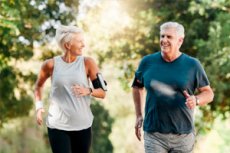Exercise is good for the brain, but improving its blood vessels may take longer
最近審查:14.06.2024

People with less stable blood flow patterns in the brain may be at greater risk of dementia and cerebrovascular disease. To explore whether regular aerobic exercise could help with this, researchers at Iowa State University conducted a pilot study, the results of which were recently published in the Journal of Applied Physiology. P>
“The main message is that exercise is good for the arteries and the brain, but the effects are complex and take time to accumulate,” said Wes Leffers, lead author and assistant professor of kinesiology.
Leffers studies large artery stiffness and brain blood flow in middle-aged people and how this affects heart and brain health later in life.
He said participants in the exercise group in the pilot study showed improvements in cognitive function and peak VO2, a measure of aerobic fitness and the body's ability to use oxygen during exercise. But to the researchers' surprise, cerebral blood flow instability increased among participants in the exercise group. Although it was not statistically significant, Leffers noted that this finding is consistent with other recent studies.
“It may be that the brain's vascular system takes longer to adapt to training compared to the heart and central vessels such as the aorta,” Leffers added, noting that other studies with year-long training have shown improvements in continuous blood flow to the brain.
p>Additional information about the pilot study The pilot study at Iowa State University included 28 participants aged 40 to 64 years. All were considered inactive and had high blood pressure or stage 1 hypertension.
Nineteen people were randomly assigned to a 12-week aerobic training program three times a week. Participants wore heart rate monitors synced to their exercise machines, which automatically adjusted speed, incline, or resistance to keep their heart rate within the target range for that session.
Participants, including those who did not participate in the exercise, were asked to maintain their normal physical and dietary lifestyle.
Researchers measured blood flow pulsatility using non-invasive Doppler ultrasound and tonometry, which measures pressure inside the eyes, at the beginning, middle and end of the pilot study. Cardiorespiratory fitness and cognitive scores on three tests were collected at the beginning and end of the study.
Leffers noted that the tasks focused on “memory and executive function, which are most strongly implicated in aging and cognitive disease.”
Specific Results Peak VO2 increased by 6% in the aerobic training group and decreased by 4% in the control group. Cerebral blood flow pulsatility tended to increase in the aerobic training group. Working memory response improved during aerobic training, but not in the control group. Marian Kohut, Barbara E. Forker Professor of Kinesiology; Angelique Brellenthin, assistant professor of kinesiology; graduate students Krista Reed and Quinn Keleher and undergraduate Abby Frescoln were co-authors of the paper.
Leffers said the research team is interested in replicating and expanding the pilot study, but with a focus on women going through menopause.
"There is evidence that the vascular benefits of exercise decline after menopause, but we don't know what happens to the cerebral vasculature and potential benefits to the brain," Leffers said.
By understanding the effects and limitations of exercise and the underlying vascular mechanisms of dementia and cerebrovascular disease, researchers hope to shed light on behavioral interventions that can improve health and quality of life.

